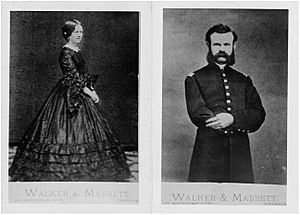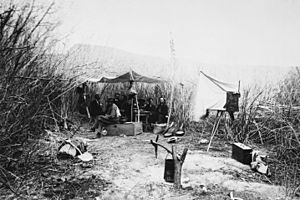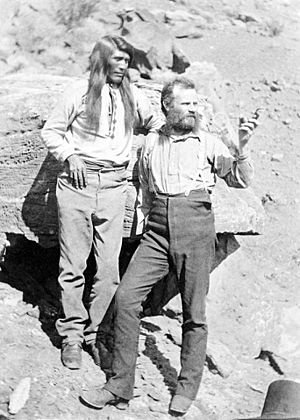John Wesley Powell facts for kids
Quick facts for kids
John Wesley Powell
|
|
|---|---|
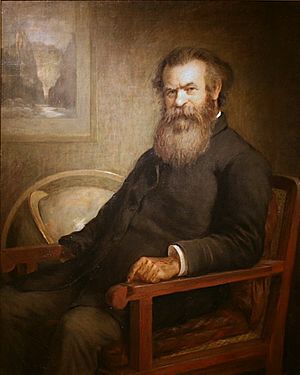
Powell as he appears at the National Portrait Gallery in Washington, D.C.
|
|
| 2nd Director of the United States Geological Survey | |
| In office 1881–1894 |
|
| Preceded by | Clarence King |
| Succeeded by | Charles Doolittle Walcott |
| Personal details | |
| Born | March 24, 1834 Mount Morris, New York |
| Died | September 23, 1902 (aged 68) Haven Colony, Brooklin, Maine |
| Resting place | Arlington National Cemetery, Section 1 |
| Nationality | American |
| Spouse | Emma Dean Powell |
| Relatives | William B Powell, brother |
| Known for | Traversing Colorado River of the Grand Canyon |
| Education |
|
| Scientific career | |
| Fields | Natural sciences |
| Institutions |
|
| Military career | |
| Allegiance | United States of America |
| Service/ |
United States Army |
| Years of service | 1861–1865 |
| Rank | Major |

John Wesley Powell (born March 24, 1834 – died September 23, 1902) was an amazing American explorer and scientist. He was a geologist, a soldier in the U.S. Army, and a professor. He also led important scientific groups.
Powell is most famous for his 1869 river trip. This three-month journey went down the Green and Colorado rivers. It was the first time a U.S. government team explored the Grand Canyon.
Later, Powell became the second director of the U.S. Geological Survey (1881–1894). He also led the Bureau of Ethnology at the Smithsonian Institution. There, he supported studies of languages and cultures.
Contents
About John Wesley Powell
Early Life and Adventures
John Wesley Powell was born in Mount Morris, New York, in 1834. His father, Joseph Powell, was a preacher who came to the U.S. from England. His family moved west, living in Ohio, Wisconsin, and Illinois.
As a young man, Powell loved exploring. In 1855, he walked across Wisconsin. The next year, he rowed the Mississippi River from Minnesota all the way to the sea. He also rowed down the Ohio River and the Illinois River. By age 25, he was part of the Illinois Natural History Society.
Education and Learning
Powell studied at several colleges, including Illinois College and Oberlin College. He spent seven years learning while also teaching. Even though he didn't get a degree, he learned a lot about Ancient Greek and Latin.
Powell was always curious about natural science. This was different from what his father wanted, but Powell was determined. In 1861, he realized a civil war was coming. He decided to study military science and engineering to get ready.
Serving in the Civil War
Powell strongly supported the Union and wanted to end slavery. In May 1861, he joined the 20th Illinois Infantry as a private. He quickly became a second lieutenant. He worked for the Union Army as a mapmaker and engineer.
While in Missouri, he formed an artillery company and became its captain. On November 28, 1861, he married Emma Dean. At the Battle of Shiloh, he was shot and lost most of his right arm. This injury caused him pain for the rest of his life.
Even with one arm, Powell returned to the Army. He fought in important battles like Champion Hill and the siege of Vicksburg. He even studied rocks while in the trenches at Vicksburg! He was promoted to major and led an artillery group during the Atlanta campaign. After the war, he was known as "Major" Powell.
After leaving the Army, Powell became a geology professor at Illinois Wesleyan University. He also lectured at Illinois State Normal University. He helped grow the collections at the Illinois Museum of Natural History. But he chose to explore the American West instead of staying in a permanent teaching job.
Exploring the American West
River Expeditions
After 1867, Powell led many trips into the Rocky Mountains and along the Green and Colorado rivers. One trip was with his students and wife to collect rock samples in Colorado. In 1868, Powell and six other men were the first white people to climb Longs Peak.
In 1869, he started his famous journey to explore the Colorado River and the Grand Canyon. He gathered ten men, four boats, and enough food for 10 months. They started from Green River, Wyoming, on May 24. They faced dangerous rapids as they traveled down the Green River. They reached the Colorado River and finished their journey on August 30, 1869.
The people on Powell's first expedition included:
- John Wesley Powell, the leader and Civil War major.
- John Colton “Jack” Sumner, a hunter and soldier.
- William H. Dunn, a hunter and trapper.
- Walter H. Powell, John's brother and a Civil War captain.
- George Y. Bradley, a Civil War lieutenant who wrote about the trip.
- Oramel G. Howland, a printer and hunter.
- Seneca Howland, a soldier wounded in the Battle of Gettysburg.
- Frank Goodman, an adventurer from England.
- W.R. Hawkins, the cook and a Civil War soldier.
- Andrew Hall, a young man from Scotland.
During the trip, they went through amazing canyons in Utah. Powell wrote in his diary about the "wonderful features—carved walls, royal arches, glens." He decided to name one beautiful area Glen Canyon.
Frank Goodman left the trip early. Dunn and the Howland brothers also left near the end. They disappeared, and some people think they were killed by Native Americans or Mormons.
Powell went back to explore parts of the Colorado River again in 1871–72. This second trip brought back many photographs, a map, and scientific papers. He worked with Jacob Hamblin, a Mormon missionary, to make sure his team would be safe from local Native American groups.
After the Colorado River Trips
In 1881, Powell became the second director of the U.S. Geological Survey. He held this important job until 1894. In 1875, Powell published a book about his explorations of the Colorado River. It was later reissued as The Exploration of the Colorado River and Its Canyons.
Years later, the diaries of other expedition members were published. These showed that some of Powell's own writings had a few exaggerations. For example, some events he wrote about from the first trip actually happened on the second. They also revealed that Powell, who had only one arm, wore a life jacket, but the other men did not.
Studying People and Cultures
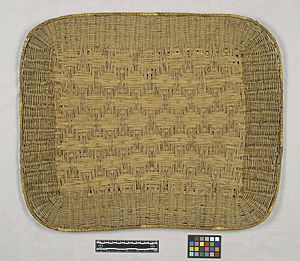
Powell became the director of the Bureau of American Ethnology at the Smithsonian Institution in 1879. He stayed in this role until he died. Under his leadership, the Smithsonian published an important way to classify North American Indian languages.
As an early anthropologist (someone who studies human cultures), Powell believed societies developed in stages. He used terms like 'savagery', 'barbarism', and 'civilization'. He thought all societies would eventually reach 'civilization'. Powell also created the word "acculturation" to describe how cultures change when they meet each other.
Powell wrote many studies about the Ute people who lived near the Colorado River canyons. He studied their customs and way of life. He believed that studying Native American cultures was important because they were "more nearly in their primate condition" (meaning closer to their original state) than other groups.
Powell helped create Illinois State University’s first Museum of Anthropology. It was considered one of the best in North America at the time.
Caring for the Environment
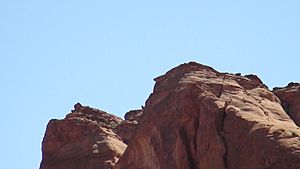
John Wesley Powell was a strong supporter of protecting land and nature. His explorations made him realize that most of the dry Western United States was not good for farming. He thought only about 2% of the land, near water sources, could be farmed.
In his book, Report on the Lands of the Arid Regions of the United States, he suggested building irrigation systems. He also proposed that state borders should follow watershed areas to avoid arguments over water. For the rest of the land, he suggested protecting it and using it for low-density animal grazing.
However, railroad companies owned huge amounts of land in the West. They disagreed with Powell's ideas because they wanted to sell their land for farming. They pushed Congress to ignore Powell's advice and encourage more people to settle and farm. Some politicians believed a theory that farming would bring more rain, known as 'rain follows the plow'. This theory was later proven wrong.
At a meeting in 1883, Powell famously warned: "Gentlemen, you are piling up a heritage of conflict and litigation over water rights, for there is not sufficient water to supply the land." His advice about developing the West was mostly ignored. This led to much hardship for pioneer farmers who failed because there wasn't enough rain or irrigation water, especially during the Dust Bowl of the 1920s and 1930s.
Legacy and Honors

John Wesley Powell was buried in Arlington National Cemetery, Virginia, because of his service to the country. A large area of land in Utah, about 29,868 acres, was named the "John Wesley Powell National Conservation Area" in 2019.
In Green River, Wyoming, where his expeditions started, there is a statue of Powell holding an oar. The USGS National Center in Reston, Virginia, is named the "John Wesley Powell Federal Building." The highest award given by the USGS to people outside the government is called the John Wesley Powell Award. In 1984, he was recognized in the Hall of Great Westerners.
Many places and things are named after Powell, including:
- The rare mineral powellite.
- Lake Powell, a large man-made lake on the Colorado River.
- Mount Powell in California.
- Powell Plateau, near the Grand Canyon.
- The town of Powell, Wyoming, and the Powell Flats area.
- A building in Grand Junction, Colorado.
- John Wesley Powell Middle School in Littleton, Colorado.
- Powell Junior High School in Mesa, Arizona.
Awards and Recognition
Powell received many honors for his work:
- 1886 - Honorary Ph.D. from University of Heidelberg.
- 1886 - Honorary LL.D. from Harvard University.
- He was elected to the National Academy of Sciences.
- He was president of the Anthropological Society of Washington (1879-1888).
- 1884 - He was president of the Philosophical Society of Washington.
- 1874 - He became a member and fellow of the American Association for the Advancement of Science (AAAS).
- 1875 - He became vice president of AAAS.
See also
In Spanish: John Wesley Powell para niños


